Properties of the Ignimbrites in the Architecture of the Historical Center of Arequipa, Peru
Abstract
:1. Introduction
2. Materials and Methods
3. Results
3.1. Macroscopic Description
3.2. Petrographic Description
3.3. Classification of Ignimbrites
3.4. Mercury Porometry
3.5. Physico-Mechanical Properties
3.6. Color Measurement
4. Discussion
5. Conclusions
Author Contributions
Funding
Institutional Review Board Statement
Informed Consent Statement
Acknowledgments
Conflicts of Interest
References
- Gutiérrez, R. Arequipa Hispánica (1540–1825). In Evolución Histórica Urbana de Arequipa (1540–1990); Facultad de Arquitectura Urbanismo y Artes UNI: Lima, Peru, 1992; pp. 36–43. [Google Scholar]
- Vatin-Perignon, N.; Poupeau, G.; Oliver, R.A.; Bellot-Gurlet, L.; Labrin, E.; Keller, F.; Salas, G. Geochemical characterization and fission track ages of historical ignimbrite flows: The sillar of Arequipa (Western cordillera, Southern Peru). In Proceedings of the Géodynamique andine: Résumés étendus, ORSTOM, 461–464, Géodynamique andine: Symposium International 2, ORSTOM 1993, Oxford, UK, 21–23 October 1993; Available online: https://hal.archives-ouvertes.fr/hal-02133522 (accessed on 4 November 2021).
- Buchiazzo, M.J. Arequipa. In Estudios de la Arquitectura Colonial Hispano Americana; Guillermo Kraft: Buenos Aires, Argentina, 1994. [Google Scholar]
- Fenner, C.N. Incandescent Tuff Flows in Southern Peru. GSA Bull. 1948, 59, 879–893. [Google Scholar] [CrossRef]
- Jenks, W.F.; Goldich, S.S. Rhyolitic Tuff Flows in Southern Peru. J. Geol. 1956, 64, 156–172. [Google Scholar] [CrossRef]
- Lebti, P.P.; Thouret, J.-C.; Wörner, G.; Fornari, M. Neogene and Quaternary ignimbrites in the area of Arequipa, Southern Peru: Stratigraphical and petrological correlations. J. Volcanol. Geotherm. Res. 2006, 154, 251–275. [Google Scholar] [CrossRef]
- Paquereau-Lebti, P. Corrélations des Ignimbrites Néogènes du sud du Pérou—Apports des Propriétés Physiques et Magnétiques à la Compréhension des Processus de Mise en Place et de Soudure. Géologie appliquée. Doctoral Thesis, Université Blaise Pascal—Clermont-Ferrand II, Aubière, France, 2006. Available online: https://tel.archives-ouvertes.fr/file/index/docid/155672/filename/perrine_paquereau_lebti.pdf (accessed on 4 November 2021).
- González, S.; Huarachi, A. Propiedades Físicas, Mecánicas y Químicas del Sillar de Arequipa y su Tratamiento con Aditivos para Evitar su Proceso de Envejecimiento (Cantera de Añashuayco). Professional Dissertation (printed copy) 2000, Consulted at the Library of the Faculty of Civil Engineering of Universidad Nacional de San Agustín, Arequipa, Peru. (archive of unpublished theses, July 2019).
- Galindo, J.C.L. Ensayos de Albañilería en Sillar, Proyecto de Investigación en Albañilería, Faculty of Science and Engineering of PUCP, Lima. 1988. Available online: http://blog.pucp.edu.pe/blog/wp-content/uploads/sites/617/2013/04/tesis_lara.pdf (accessed on 4 November 2021).
- Ulloa, H. El Sillar. Professional Dissertation (printed copy) 1970, Consulted at the Library of the Faculty of Civil Engineering of Universidad Nacional de San Agustín, Arequipa, Peru. (archive of unpublished thesis, July 2019).
- Albini, P.; Musson, R.M.W.; Gomez Capera, A.A.; Locati, M.; Rovida, A.; Stucchi, M.; Viganò, D. Global Historical Earthquake Archive and Catalogue (1000–1903). In GEM Technical Report 2013-01 V1.0.0; GEM Foundation: Pavia, Italy, 2013; 202p. [Google Scholar] [CrossRef]
- Florez, D.M.M.G.; Ale, R.B.G.; Idme, A.F.H.; Alarcon, L.A.L.; Huallpa, E.A.; Castro, Y.; Apestegui, P.G.R.; Rodriguez, J.M.R. SiO2-TiO2 Films Supported on Ignimbrite by Spray Coating for the Photocatalytic Degradation of NOx Gas and Methyl Orange Dye. Int. J. Photoenergy 2020, 2020, 4756952. [Google Scholar] [CrossRef] [Green Version]
- Alavi, H. Evaluación de Peligro por Ocurrencia de Lahares (Flujos de Lodo) en el Complejo Volcánico Chachani-Arequipa. Professional Dissertation, Universidad Nacional de San Antonio de Cusco, Cusco, Oeru, 2020. Available online: http://repositorio.unsaac.edu.pe/handle/UNSAAC/5108 (accessed on 4 November 2021).
- Barahona, H.P.A.; Vera, C.C.T.; Machaca, J.Z. Entidades del geosistema de las canteras de sillar de Añashuayco, en Arequipa. Rev. Cienc. Desarro. 2006, 7, 49–59. [Google Scholar] [CrossRef] [Green Version]
- ISO 15901-2. Pore Size Distribution and Porosity of Solid Materials by Mercury Porosimetry and Gas Adsorption—Part 2: Analysis of Mesopores and Macropores by Gas Adsorption; ISO: Geneva, Switzerland, 2006. [Google Scholar]
- Benavente, D.; Martínez-Martínez, J.; Cueto, N.; Garcia-Del-Cura, M.A. Salt weathering in dual-porosity building dolostones. Eng. Geol. 2007, 94, 215–226. [Google Scholar] [CrossRef]
- Çelik, S.B.; Çobanoğlu, I. Comparative investigation of Shore, Schmidt, and Leeb hardness tests in the characterization of rock materials. Environ. Earth Sci. 2019, 78, 554. [Google Scholar] [CrossRef]
- EN ISO 105-J03:2009. Textiles. Tests for Colour Fastness. Part J03: Calculation of Colour Differences; ISO: Geneva, Switzerland, 2009. [Google Scholar]
- Grossi, C.M.; Brimblecombe, P.; Esbert, R.M.; Alonso, F.J. Color changes in architectural limestones from pollution and cleaning. Color Res. Appl. 2007, 32, 320–331. [Google Scholar] [CrossRef]
- Amstutz, G.C.; Giger, H. Stereological methods applied to mineralogy, petrology, mineral deposits and ceramics. J. Microsc. 1972, 95, 145–164. [Google Scholar] [CrossRef]
- Le Maitre, R.W.; Streckeisen, A.; Zanettin, B.; Le Bas, M.J.; Bonin, B.; Bateman, P. (Eds.) Igneous Rocks: A Classification and Glossary of Terms, Recommendations of the International Union of Geological Sciences Subcommission on the Systematics of Igneous Rocks, 2nd ed.; Cambridge University Press: Cambridge, UK, 2002. [Google Scholar] [CrossRef]
- Öner, F.; Türkmen, S.; Özbek, A.; Karakaya, T. Engineering properties of Hınıs ignimbrites and their usability as a building stone (Erzurum, Turkey). Environ. Earth Sci. 2006, 50, 275–284. [Google Scholar] [CrossRef]
- Martínez-Martínez, J.; Pola, A.; García-Sánchez, L.; Agustin, G.R.; Ocampo, L.S.O.; Vázquez, J.L.M.; Robles-Camacho, J. Building stones used in the architectural heritage of Morelia (México): Quarries location, rock durability and stone compatibility in the monument. Environ. Earth Sci. 2018, 77, 167. [Google Scholar] [CrossRef]
- Işık, E.; Büyüksaraç, A.; Avşar, E.; Kuluöztürk, M.F.; Günay, M. Characteristics and properties of Bitlis ignimbrites and their environmental implications. Mater. Construcción 2020, 70, 214. [Google Scholar] [CrossRef] [Green Version]
- Barbero-Barrera, M.M.; Flores-Medina, N.; Moreno-Fernández, E. Thermal, physical and mechanical characterization of volcanic tuff masonries for the restoration of historic buildings. Mater. Construcción 2019, 69, 179. [Google Scholar] [CrossRef]
- Cueto, N.; Vieira De Sousa, J.F.; Fernandes, C.; Benavente, D.; Urbani, F.; Meza, R.; Fernandes, E.; García del Cura, M.A. Water transport in lapilli tuff from Madeira Island, Portugal: Implications on degradation mechanisms and durability. In Proceedings of the 16CNG Congreso Nacional de Géotecnia, Açores, Portugal, 27–30 May 2018; p. 12. [Google Scholar]
- Martínez, A.P. Comportamiento Mecánico de las Rocas Volcánicas (Mechanical Behavior of Volcanic Rocks). Ingeniería Civil 186/2017:39–63. Available online: http://ingenieriacivil.cedex.es/index.php/ingenieria-civil/article/view/26/20 (accessed on 11 July 2021).
- Heap, M.J.; Farquharson, J.I.; Kushnir, A.R.L.; Lavallée, Y.; Baud, P.; Gilg, H.A.; Reuschlé, T. The influence of water on the strength of Neapolitan Yellow Tuff, the most widely used building stone in Naples (Italy). Bull. Volcanol. 2018, 80, 51. [Google Scholar] [CrossRef]
- Binal, A. Prediction of mechanical properties of non-welded and moderately welded ignimbrite using physical properties, ultrasonic pulse velocity, and point load index tests. Q. J. Eng. Geol. Hydrogeol. 2009, 42, 107–122. [Google Scholar] [CrossRef]
- Aldeeky, H.; Al Hattamleh, O.; Rababah, S. Assessing the uniaxial compressive strength and tangent Young’s modulus of basalt rock using the Leeb rebound hardness test. Mater. Construcción 2020, 70, 230. [Google Scholar] [CrossRef]
- YüksekS. Mechanical properties of some building stones from volcanic deposits of mount Erciyes (Turkey). Mater. Construcción 2019, 69, 187. [Google Scholar] [CrossRef] [Green Version]
- Quane, S.L.; Russell, J.K. Ranking welding intensity in pyroclastic deposits. Bull. Volcanol. 2004, 67, 129–143. [Google Scholar] [CrossRef]
- Koralay, T.; Özkul, M.; Kumsar, H.; Çelik, S.B.; Pektaş, K. The effect of welding degree on geotechnical properties of an ignimbrite flow unit: The Bitlis castle case (eastern Turkey). Environ. Earth Sci. 2011, 64, 869–881. [Google Scholar] [CrossRef]
- Calcaterra, D.; Cappelletti, P.; Langella, A.; Colella, A.; de Gennaro, M. The ornamental stones of Caserta province: The Campanian Ignimbrite in the medieval architecture of Casertavecchia. J. Cult. Herit. 2004, 5, 137–148. [Google Scholar] [CrossRef]
- Bustamante, R.; Vázquez, P.; Llerena, K.; Prendes, N. Reinterpretation of Flat Sculpting of Arequipa’s Ignimbrite Cultural heritage. In Proceedings of the 8th Euro-American Congress on Construction Pathology, Rehabilitation Technology and Heritage Management, ed. REHABEND 2020, Granada, Spain, 24–27 March 2020; pp. 1451–1458. [Google Scholar]
- SENAHMI. Ciclos Horarios de Precipitación en el Perú Utilizando Información Satelital (PET: Precipitation Rate Provided by Satellite Information TRMM 3B42 Every 3 Hours), Lima, November 2016. Available online: https://www.senamhi.gob.pe/load/file/01401SENA-34.pdf (accessed on 4 November 2021).
- Espinoza, F.S.; Horn, M.; Gomez, M.M.; Solis, J.L. Thermal, structural and mechanical characterization of the whitish Arequipa Airport Ignimbrite. J. Phys. Conf. Ser. 2021, 1841, 012010. [Google Scholar] [CrossRef]
- Koralay, T.; Çelik, S.B. Minero-petrographical, physical, and mechanical properties of moderately welded ignimbrite as a traditional building stone from Uşak Region (SW Turkey). Arab. J. Geosci. 2019, 12, 732. [Google Scholar] [CrossRef]
- Topal, T.; Sözmen, B. Deterioration mechanisms of tuffs in Midas monument. Eng. Geol. 2003, 68, 201–223. [Google Scholar] [CrossRef]
- Vazquez, P.; Acuña, M.; Benavente, D.; Gibeaux, S.; Navarro, I.; Gomez-Heras, M. Evolution of surface properties of ornamental granitoids exposed to high temperatures. Constr. Build. Mater. 2016, 104, 263–275. [Google Scholar] [CrossRef]
- Pola, A.; Crosta, G.; Fusi, N.; Barberini, V.; Norini, G. Influence of alteration on physical properties of volcanic rocks. Tectonophysics 2012, 566–567, 67–86. [Google Scholar] [CrossRef]
- Bonomo, A.E.; Amodio, A.M.; Prosser, G.; Sileo, M.; Rizzo, G. Evaluation of soft limestone degradation in the Sassi UNESCO site (Matera, Southern Italy): Loss of material measurement and classification. J. Cult. Herit. 2020, 42, 191–201. [Google Scholar] [CrossRef]
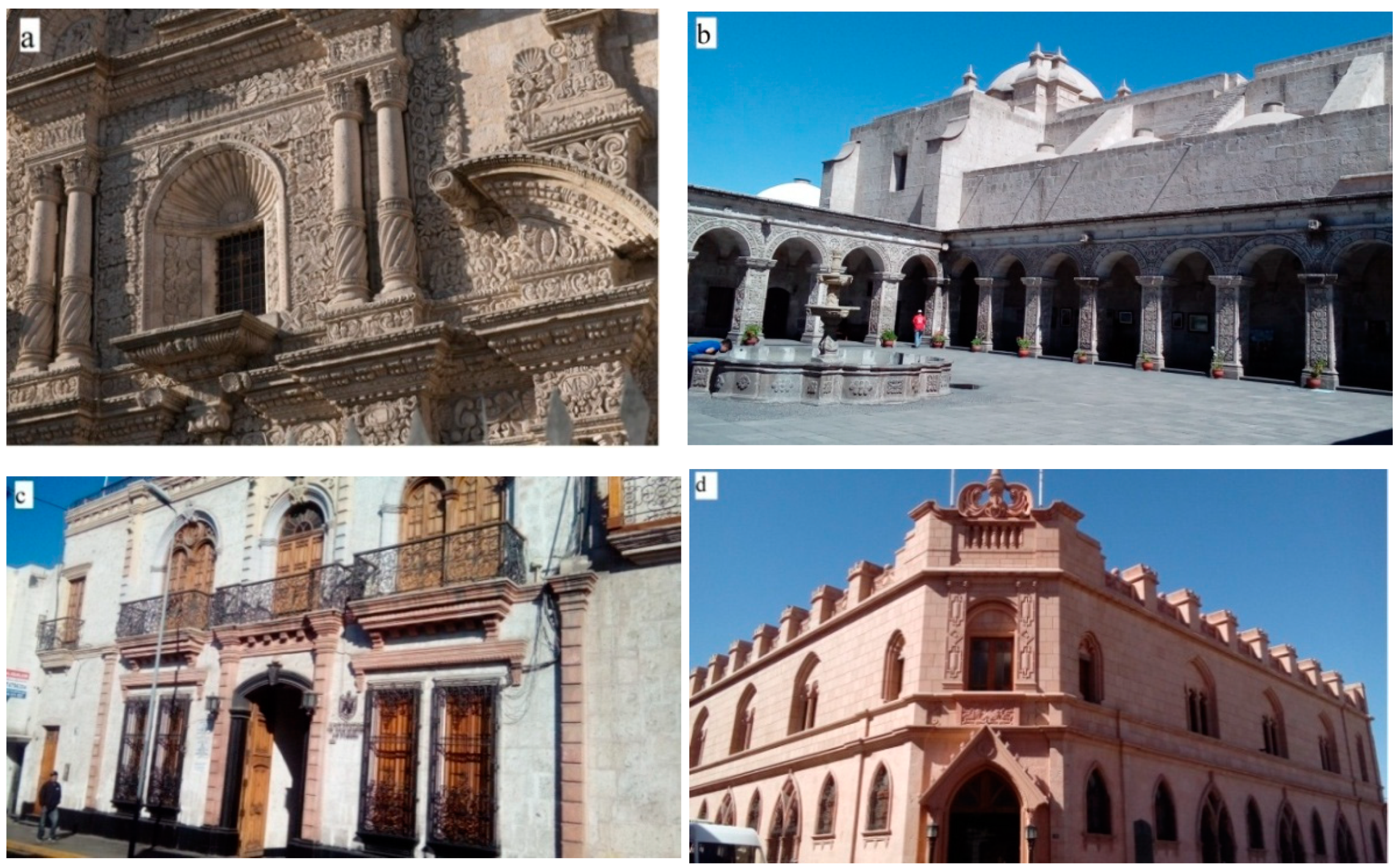
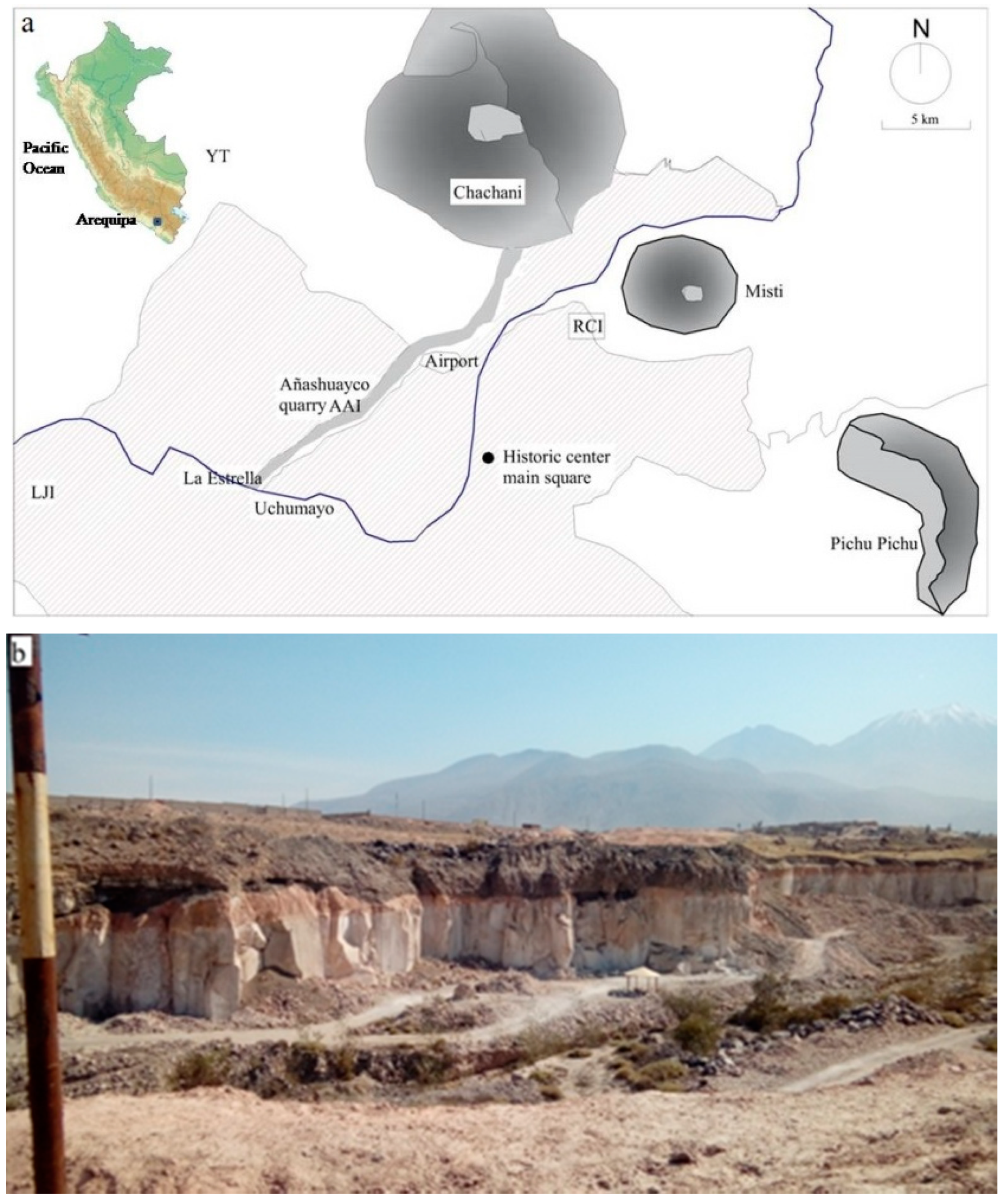

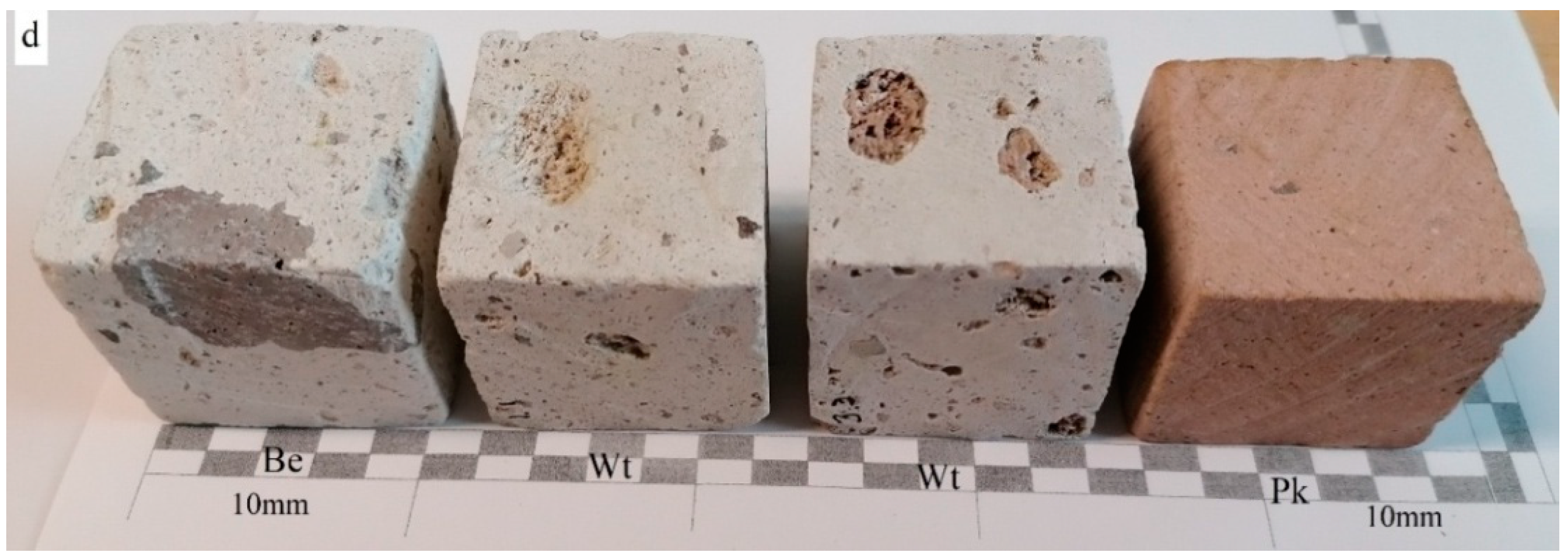
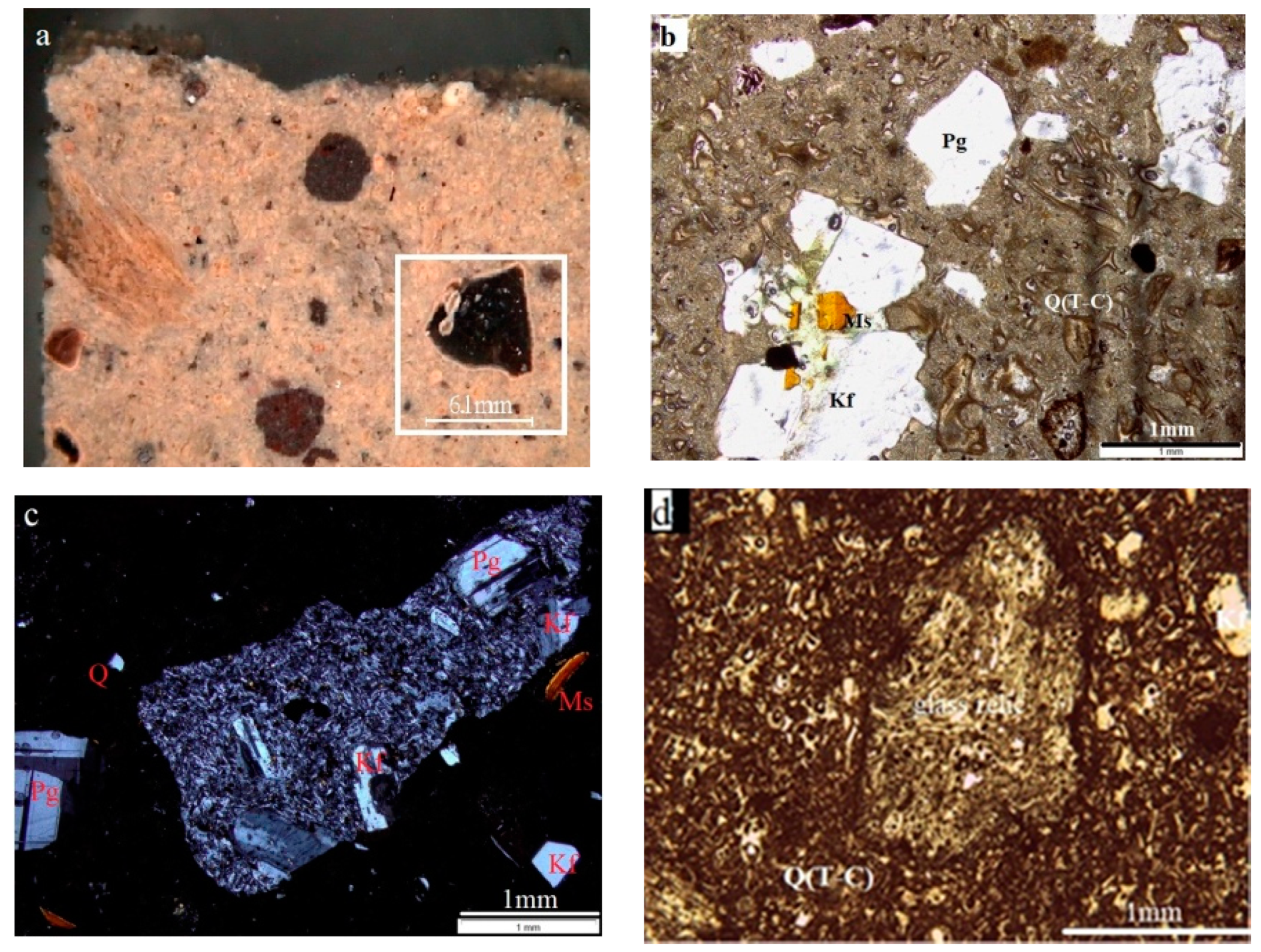
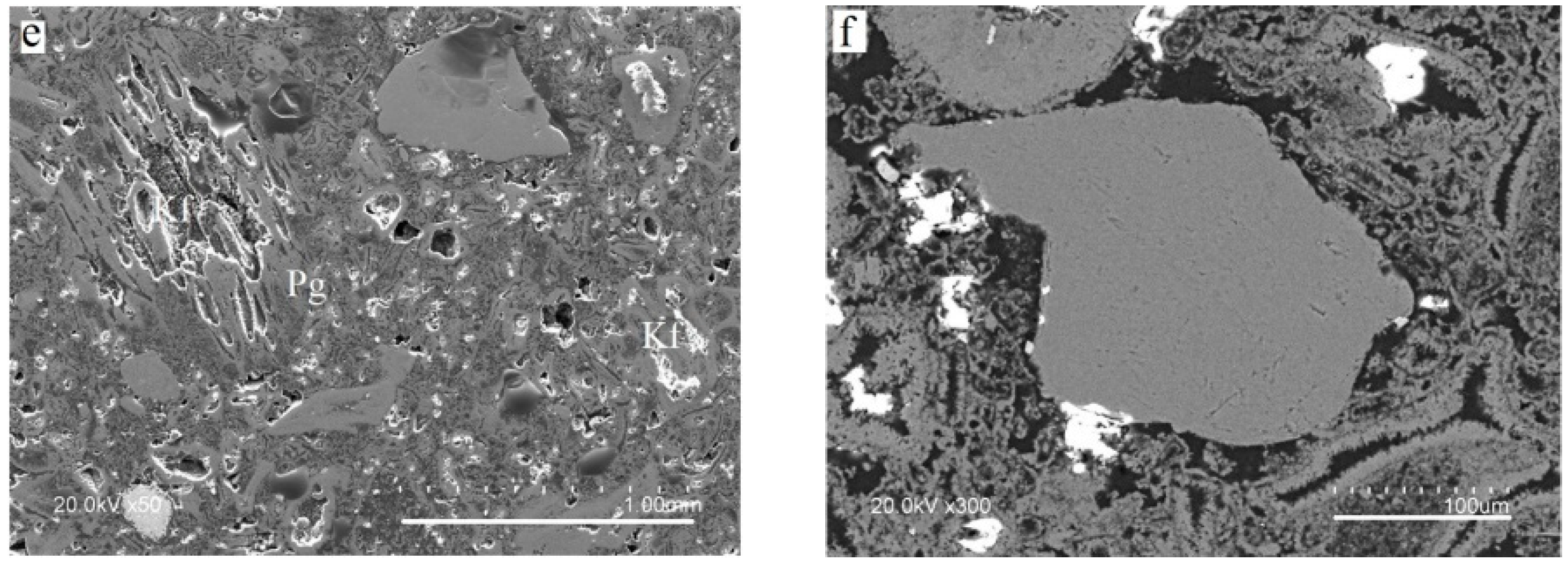
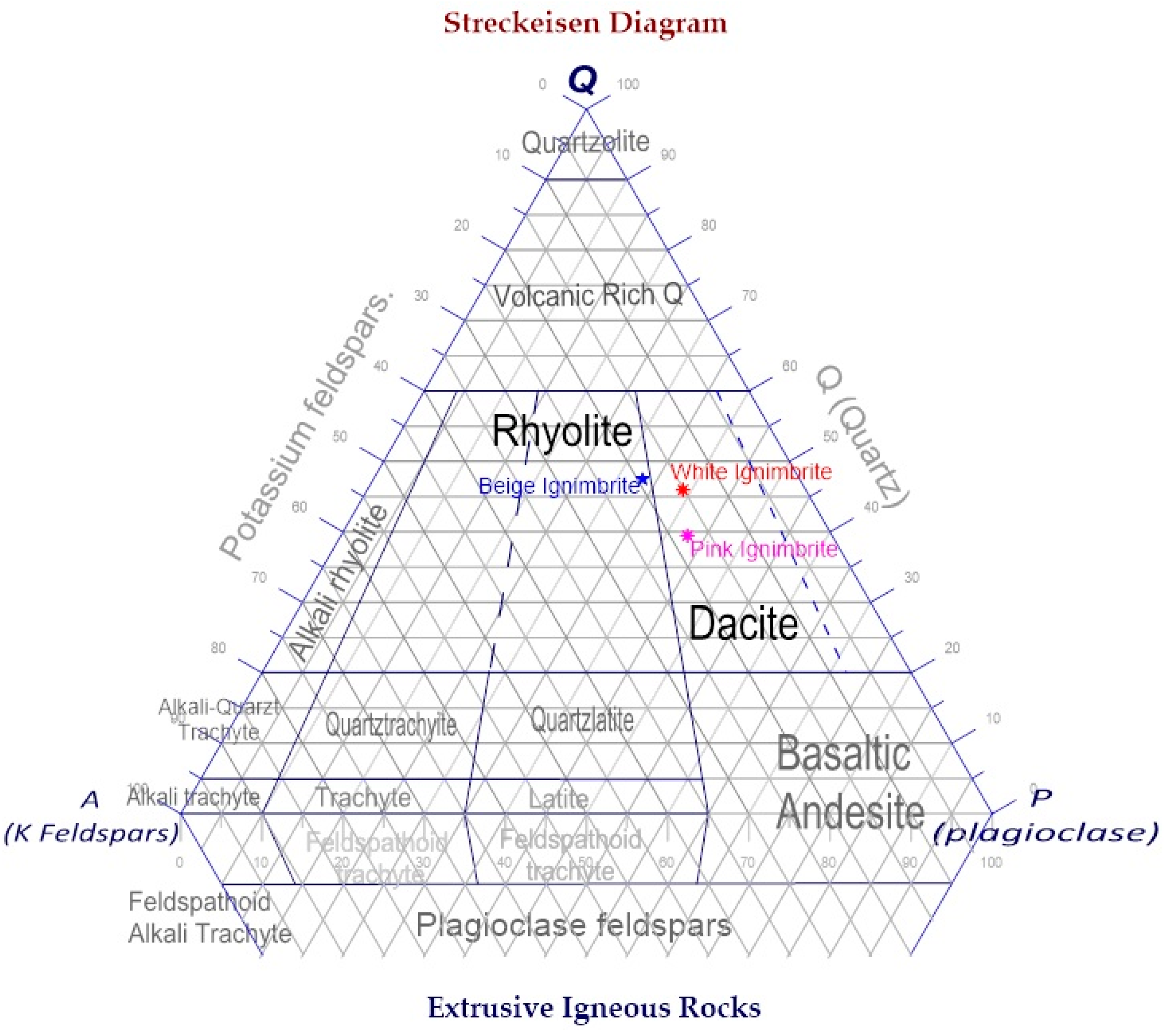
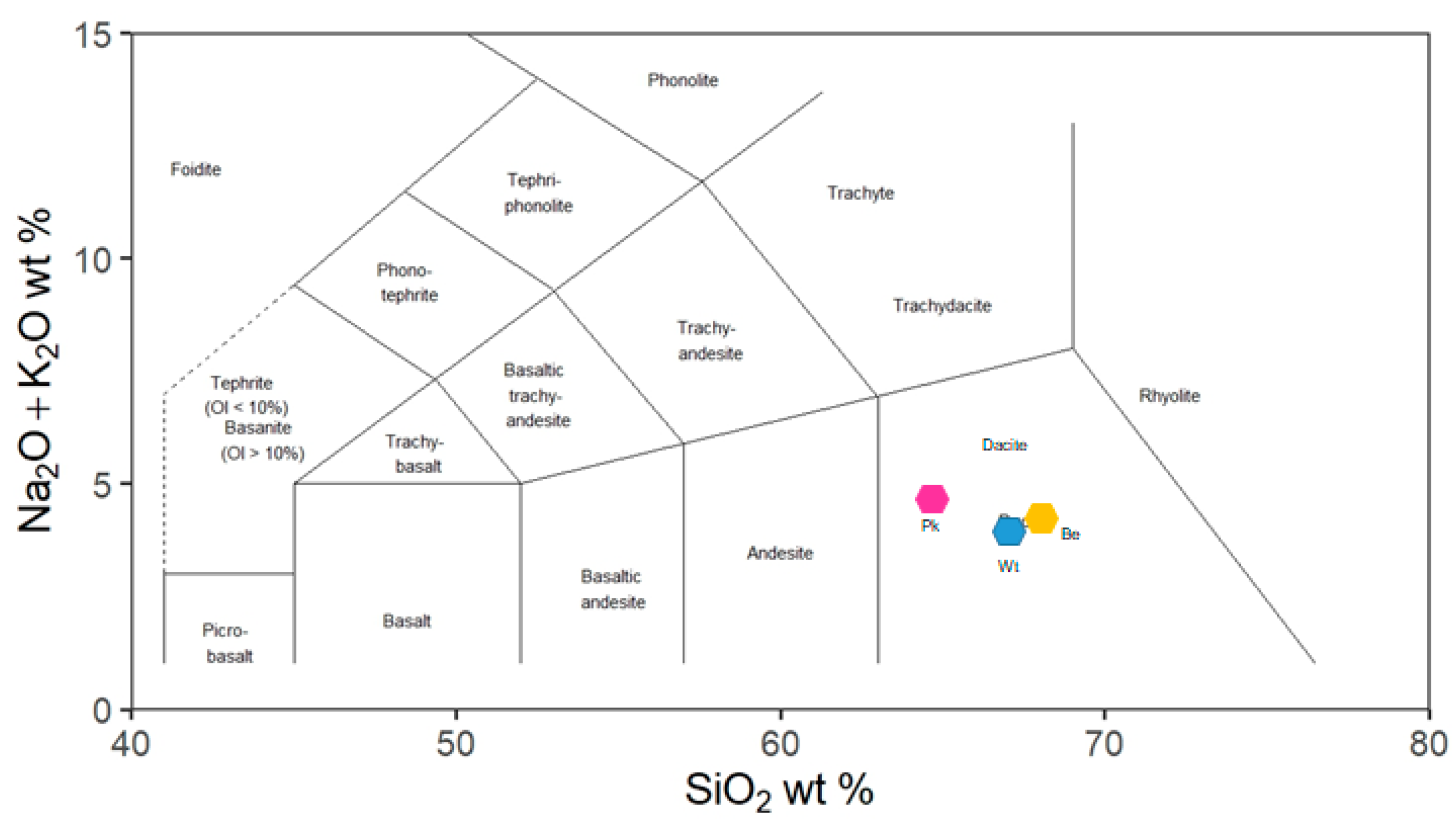


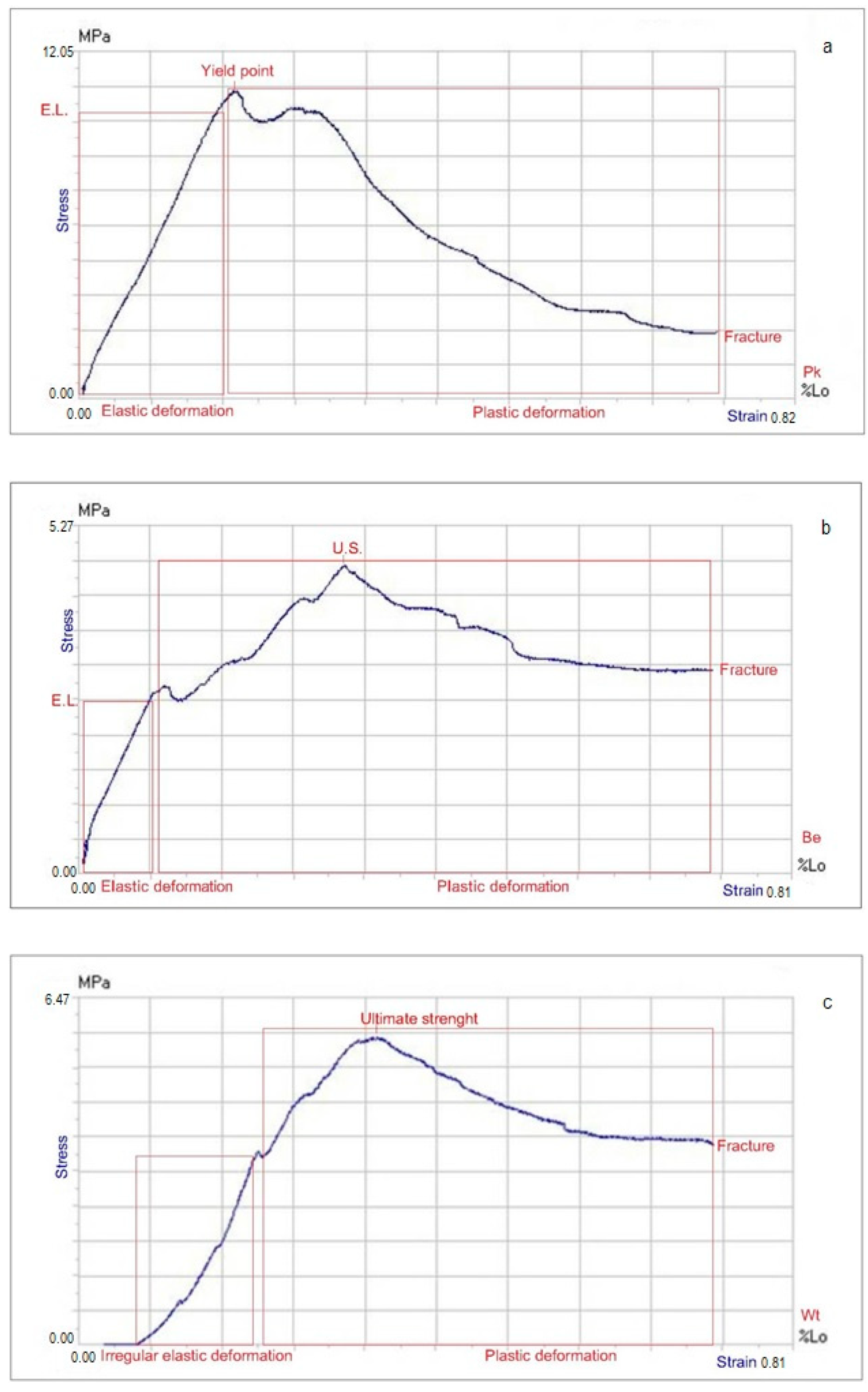
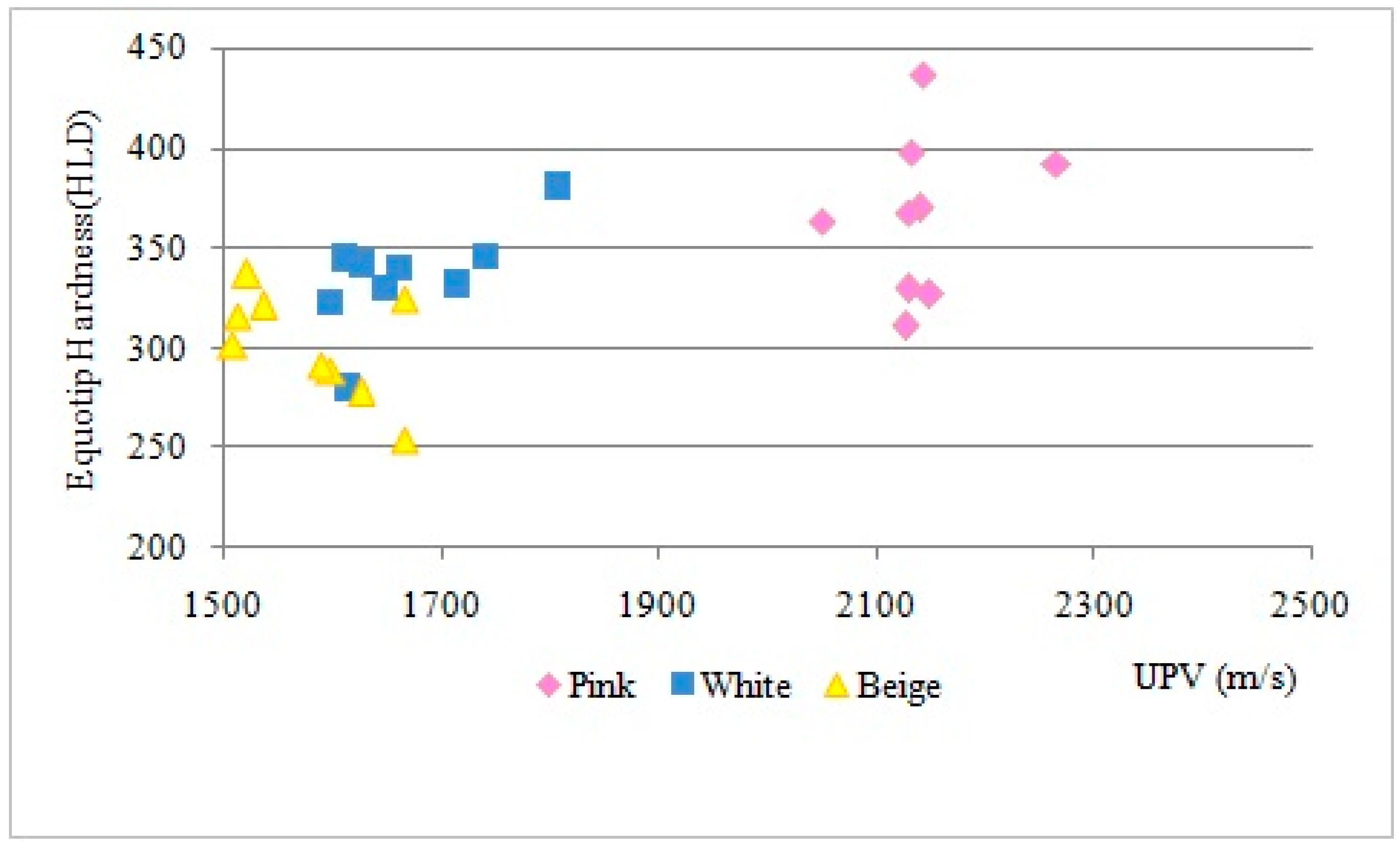
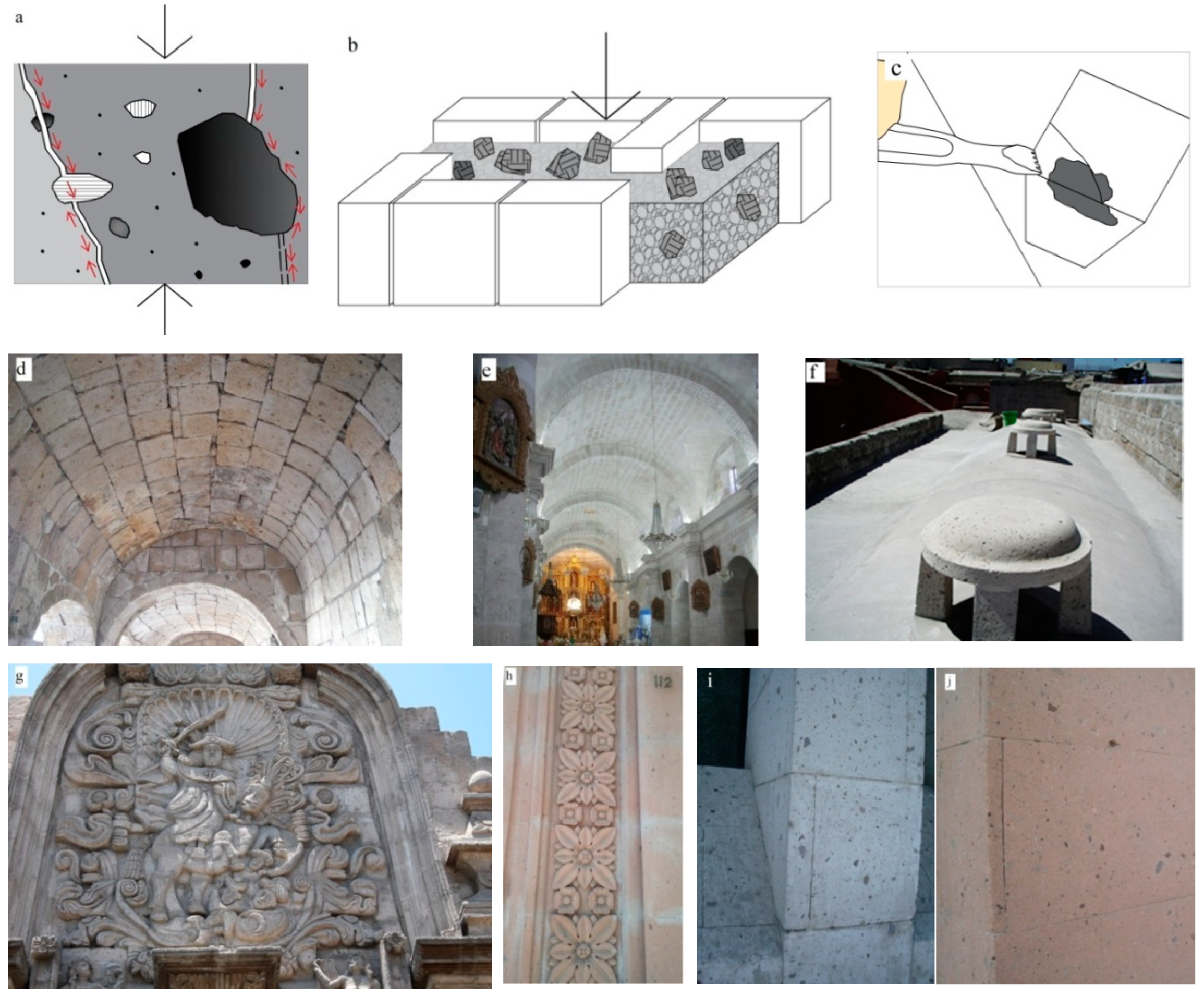
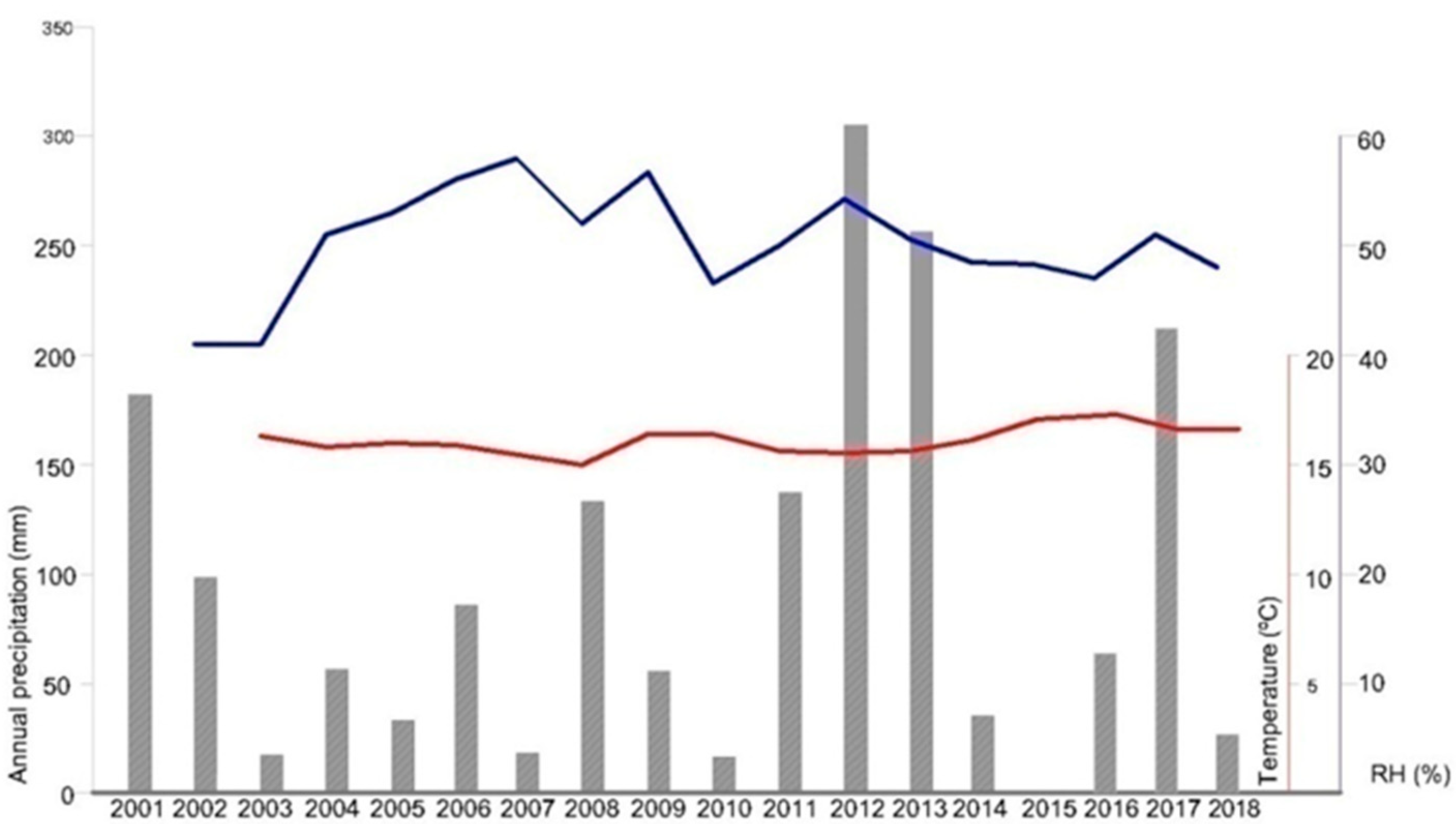
| Ignimbrite Sample Minerals (%) | Wt | Be | Pk | Vacuole Pumice |
|---|---|---|---|---|
| Cristobalite α SiO2 | 15 | 15 | 5 | 16 |
| Tridymite SiO2 | 2 | 2 | 7 | |
| Potassic Feldspar (Sanidine) K(AlSi3)O8 | 22 | 21 | 14 | 26 |
| Plagioclase (Albitehigh) Na(AlSi3O8) | 51 | 54 | 66 | 47 |
| Phyllosilicates K (Mg, Fe)3(AlSi3O10)(OH)2 Biotite and Muscovite | 8 | 7 | 8 | 6 |
| Hematite Fe2O3 | 2 | 1 | ||
| Amphiboles Ca2(Mg, Fe, Al)5(Al, Si)8O22(OH)2 | 4 | |||
| SodaliteNa8Al6Si6O24Cl2 | 1 |
| Ignimbrites | SiO2 | K2O | Na2O | Fe3O4 |
|---|---|---|---|---|
| Wt | 66.9% a | 3.6% a 3.3% b | 0.4% b | 0.9% a 1.0% b |
| Be | 67.9% a | 3.8% a 3.7% b | 0.4% b | 1.0% a 1.1% b |
| Pk | 64.4% a | 3.7% a 2.8% b | 0.8% b | 0.8% a 0.8% b |
| Variety | ρ kg/m3 | Ab (%) | C g/m2·s0.5 | UPV m/s | Fs MPa | UCS MPa | Edyn GPa |
|---|---|---|---|---|---|---|---|
| Wt [7] | 1200 1300 | ||||||
| Wt [8] | 1240 | 25.23 | 2.43 | 9.34 | |||
| Wt [9] | 1260 | 27.88 | 1.38 | 8.79 | |||
| Wt [10] | 1260 | 31 ± 0.26 | 429 ±5 | 2.14 | 9.35 | ||
| This study | |||||||
| Wt | 1350 | 25 ± 1.46 | 272 ± 13 | 1853 ± 29 | 1.5 ± 0.5 | 7 ± 2 | 4.63 |
| Be | 1310 | 27 ± 2.38 | 295 ± 17 | 1709 ± 53 | 2 ± 0.5 | 5 ± 1 | 3.64 |
| Pk | 1518 | 16 ± 0.49 | 275 ± 1 | 2141 ± 34 | 13 ± 3 | 7 |
| L* | a* | b* | ||
|---|---|---|---|---|
| Wt | Avrg. | 80.2 | 1.3 | 4.8 |
| st.dev. | ±2.1 | ±0.2 | ±0.9 | |
| Be | Avrg. | 78.4 | 1.8 | 9.3 |
| st.dev. | ±1.6 | ±0.2 | ±0.8 | |
| Pk | Avrg. | 66.3 | 7.4 | 11.8 |
| st.dev. | ±0.9 | ±0.4 | ±0.5 | |
| Wt-Be | Be-Pk | Wt-Pk | ||
| ∆E* | 4.95 | 13.51 | 16.76 |
Publisher’s Note: MDPI stays neutral with regard to jurisdictional claims in published maps and institutional affiliations. |
© 2021 by the authors. Licensee MDPI, Basel, Switzerland. This article is an open access article distributed under the terms and conditions of the Creative Commons Attribution (CC BY) license (https://creativecommons.org/licenses/by/4.0/).
Share and Cite
Bustamante, R.; Vazquez, P.; Prendes, N. Properties of the Ignimbrites in the Architecture of the Historical Center of Arequipa, Peru. Appl. Sci. 2021, 11, 10571. https://doi.org/10.3390/app112210571
Bustamante R, Vazquez P, Prendes N. Properties of the Ignimbrites in the Architecture of the Historical Center of Arequipa, Peru. Applied Sciences. 2021; 11(22):10571. https://doi.org/10.3390/app112210571
Chicago/Turabian StyleBustamante, Rosa, Patricia Vazquez, and Nicanor Prendes. 2021. "Properties of the Ignimbrites in the Architecture of the Historical Center of Arequipa, Peru" Applied Sciences 11, no. 22: 10571. https://doi.org/10.3390/app112210571
APA StyleBustamante, R., Vazquez, P., & Prendes, N. (2021). Properties of the Ignimbrites in the Architecture of the Historical Center of Arequipa, Peru. Applied Sciences, 11(22), 10571. https://doi.org/10.3390/app112210571






